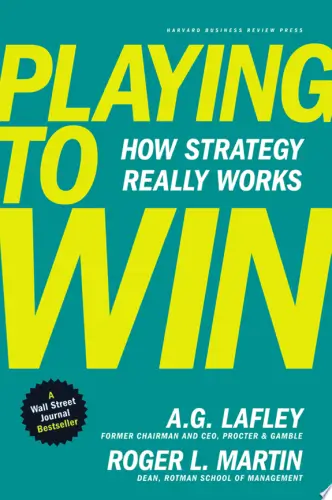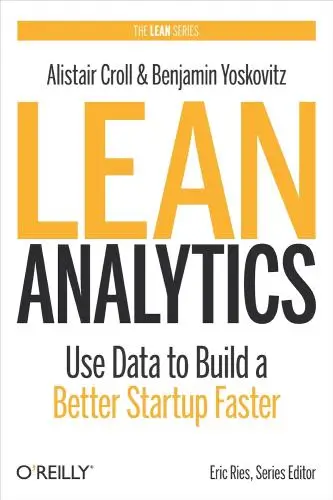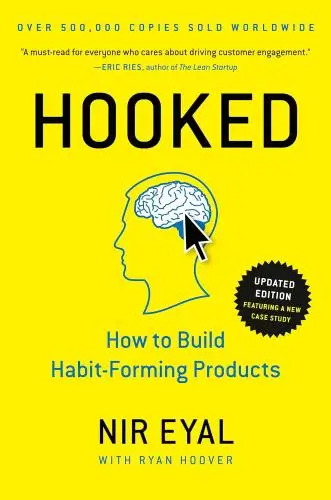Hooked
How to Build Habit-Forming Products
What's it about?
Hooked reveals the secrets behind habit-forming products and how companies like Facebook, Instagram, and Google create addictive user experiences. Eyal's "Hook Model" breaks down the four key stages of building habit-forming products: Trigger, Action, Variable Reward, and Investment. By understanding these principles, businesses can create products that keep users coming back for more. Whether you're a product designer, marketer, or entrepreneur, Hooked is a must-read for anyone looking to understand what makes a product truly engaging.
About the Author
Nir Eyal is a bestselling author known for his expertise in behavioral design and habit formation. His book "Hooked: How to Build Habit-Forming Products" explores the psychology behind creating addictive technologies. Eyal's writing style is engaging and practical, offering actionable insights for entrepreneurs and designers. He delves into topics such as consumer behavior, motivation, and creating products that capture users' attention. Eyal's work sheds light on the ways technology shapes our behavior and how we can harness these insights for positive change.
10 Key Ideas of Hooked
Creating User Habits Through Trigger Design
Design products that incorporate both external and internal triggers.
External triggers, such as emails and notifications, draw users in.
Internal triggers, like emotions or routines, keep them coming back.
By associating your product with specific user states or emotions, you can create a habit-forming loop.
This loop ensures that the product becomes the go-to solution for a particular need or feeling.
Learn DeeperIdentify the Emotions or Routines Your Product Addresses: Start by understanding the internal triggers your potential users experience. Are they seeking entertainment because they're bored? Looking for social connection when they feel lonely? By pinpointing these emotions or routines, you can tailor your product to become the natural solution.
Design External Triggers That Match User Needs: Once you know what internal triggers you're targeting, create external triggers like notifications, emails, or social media ads that speak directly to those needs. For example, if your product helps with productivity, a morning email reminding users to plan their day can be very effective.
Create a Seamless Transition from Trigger to Action: Ensure that when a user interacts with an external trigger, the path to using your product is as frictionless as possible. This might mean simplifying the sign-up process, making the app more intuitive, or providing immediate value that confirms the user's decision to engage.
Reinforce the Habit Loop: After users have taken the desired action, provide them with a reward that reinforces the habit. This could be a sense of accomplishment, social recognition, or even something tangible within the app. Over time, this reward helps solidify the habit, making your product the go-to solution whenever the internal trigger occurs.
- Example
A meditation app sends a push notification in the early evening, a time when users might feel stressed from their day. The notification offers a quick, 5-minute guided session to help unwind. This external trigger addresses the internal feeling of stress, guiding the user towards forming a habit of meditating to relax.
- Example
A fitness tracking app sends a congratulatory email after a user completes their first week of workouts. The email highlights their progress and encourages them to keep going. This external trigger, combined with the internal desire to improve fitness, helps reinforce the habit of daily exercise.
Enhancing User Engagement with Variable Rewards
Implement a system of variable rewards to make product interactions more engaging and unpredictable.
This taps into the human desire for novelty and surprise, encouraging users to return to the product repeatedly.
Rewards can vary in type, such as social validation, material gain, or personal gratification, ensuring a wide appeal across different user motivations.
Learn DeeperIdentify Your Reward Categories: Start by pinpointing what types of rewards would most appeal to your users. Consider social validation (likes, shares, comments), material gain (discounts, gifts), and personal gratification (achievements, milestones).
Implement a Variable Reward System: Integrate a system where rewards are not given out predictably. For example, after completing a task or action, the reward type or size should vary. This unpredictability keeps the experience fresh and engaging.
Monitor and Adjust: Keep an eye on how your users respond to the different types of rewards and the variability of these rewards. Use analytics to understand what works best and be prepared to adjust your strategy based on user feedback and engagement metrics.
Educate Your Users: Make sure your users understand how the reward system works but keep some elements of surprise. This can be done through tutorials, FAQs, or introductory emails. Transparency builds trust, while the element of surprise maintains engagement.
- Example
A fitness app that rewards users with points for workouts completed. The points can be random or based on the workout's difficulty, and they can be redeemed for rewards like virtual badges, discount codes for fitness gear, or a feature that unlocks new exercises.
- Example
A social media platform that introduces a 'mystery box' for users who engage regularly. The box could contain anything from a profile badge highlighting the user as a top contributor, to exclusive access to new features, or even a physical gift sent to their home.
Simplifying the Action Phase to Boost Response
Reduce the effort required for users to take the desired action within your product.
The easier it is for users to perform an action, the more likely they are to do it.
This involves streamlining user interfaces, removing unnecessary steps, and clearly guiding users towards the next action.
A smooth, frictionless experience encourages habitual use.
Learn DeeperIdentify the core action you want users to take on your product or service. This could be making a purchase, signing up for a newsletter, or sharing content. Clearly defining this action is the first step towards simplifying the process.
Analyze the current process required to perform this action. Look for any unnecessary steps that could be eliminated without sacrificing the quality of the user experience. This might involve combining two steps into one or removing the need for redundant information.
Optimize the user interface for simplicity and ease of use. This could mean larger buttons, clearer calls-to-action, and minimizing the amount of text users need to read to understand what they need to do next.
Automate where possible to reduce user effort. If your platform can remember user preferences or fill in details automatically, implement these features to make actions quicker and easier.
Test and iterate based on user feedback. Simplification is an ongoing process. Use A/B testing to compare different versions of your process and see which one performs better. Always be open to refining your approach based on how real users interact with your product.
- Example
A shopping app reduces the checkout process from five steps to just two by allowing users to save their shipping and payment information. This simplification leads to a noticeable increase in completed purchases.
- Example
A content platform introduces a 'Read Later' button directly beside article titles, eliminating the need to open the article before saving it. This small change significantly increases the number of articles saved for later reading, enhancing user engagement.
Investment Phase: Encouraging User Contributions
Prompt users to make small investments in your product, such as personalizing their profile or contributing content.
These investments increase the user's sense of ownership and commitment, making them more likely to return.
Additionally, these actions improve the service for the user over time, creating a more personalized and valuable experience.
Learn DeeperPersonalize Your Experience: Whenever you sign up for a new service or app, take a few moments to customize your profile. Add a profile picture, fill out your interests, or set your preferences. This small investment not only makes the platform more enjoyable for you but also increases your likelihood of sticking with it.
Contribute Content: If the platform allows, start contributing your own content. This could be posting on a forum, uploading photos, writing reviews, or sharing articles. These contributions not only enrich the community but also deepen your connection to the service, making you more likely to return.
Engage with Others: Make an effort to engage with other users' content by liking, commenting, or sharing. This interaction not only builds a sense of community but also personalizes your feed, making the content you see more relevant and engaging over time.
Track Your Progress: If the service includes progress tracking or goal setting, make sure to use these features. Setting goals and monitoring your progress can increase your commitment and satisfaction with the service.
- Example
On a fitness app, you might start by setting up your fitness goals, tracking your daily workouts, and participating in community challenges. Over time, this not only personalizes your experience but also motivates you to keep using the app.
- Example
On a language learning platform, you could begin by choosing the languages you're interested in and completing a placement test to personalize your learning path. Then, regularly contribute by participating in forum discussions or peer reviewing others' exercises. This engagement enhances your learning experience and keeps you motivated.
Leveraging User Data for Personalized Experiences
Collect and analyze user data to offer personalized experiences.
By understanding user behavior, preferences, and engagement patterns, you can tailor your product to meet individual needs better.
Personalization enhances the perceived value of your product, making it more relevant and attractive to users, thereby fostering loyalty and habitual use.
Learn DeeperIdentify Key Data Points: Start by determining which user data points are most relevant to your product or service. This could include user behavior on your platform, purchase history, or content preferences. Use tools like Google Analytics or in-app analytics to gather this data.
Segment Your Users: Group your users based on shared characteristics or behaviors. For example, you might segment them by age, location, or how frequently they use your product. This allows you to tailor your offerings more precisely.
Implement Personalization Algorithms: Use algorithms or machine learning models to analyze user data and predict what kind of content or products might appeal to each segment. This could mean recommending products similar to past purchases or content that matches their interests.
Test and Iterate: Continuously test different personalization strategies to see what works best. Use A/B testing to compare the effectiveness of different personalized experiences. Based on the results, refine your approach to better meet your users' needs.
Ensure Privacy and Transparency: Make sure to comply with data protection regulations and be transparent with your users about how their data is being used. Offer options for users to control their data or opt out of certain types of data collection.
- Example
A streaming service like Netflix uses viewing history and ratings to recommend other shows or movies that the user might like, creating a highly personalized viewing experience.
- Example
An e-commerce platform like Amazon analyzes past purchases, search history, and item views to suggest products that the user is likely to be interested in, enhancing the shopping experience and potentially increasing sales.
Deeper knowledge. Personal growth. Unlocked.
Unlock this book's key ideas and 15M+ more. Learn with quick, impactful summaries.
Read Full SummarySign up and read for free!
Hooked Summary: Common Questions
Experience Personalized Book Summaries, Today!
Discover a new way to gain knowledge, and save time.
Sign up for our 7-day trial now.
No Credit Card Needed

Similar Books

$100M Offers
Alex Hormozi
Principles of Marketing, Global Edition
Gary Armstrong
The 100 Best Business Books of All Time
Jack Covert
Playing to Win
A.G. Lafley
Productize
Eisha Armstrong
Start Your Own Pet-Sitting Business and More
Entrepreneur Press
The 22 Immutable Laws of Marketing
Al Ries
The Upstarts
Brad Stone
Lean Analytics
Alistair Croll
Built to Sell
John WarrillowTrending Summaries

Peak
Anders Ericsson
Never Split the Difference
Chris Voss
Smart Brevity
Jim VandeHei
The Psychology of Money
Morgan Housel
The First 90 Days
Michael D. Watkins
Atomic Habits
James Clear
Thinking, Fast and Slow
Daniel Kahneman
The Body Keeps the Score
Bessel van der Kolk M.D.
The Power of Regret
Daniel H. Pink
The Compound Effect
Darren HardyNew Books

Job Interviews For Dummies®
Joyce Lain Kennedy
Job Interviews In A Week
Alison Straw
Handbook of Career Development
Gideon Arulmani
The Art of Spending Money
Morgan Housel
$100M Offers
Alex Hormozi
A Candle for Kiri
Edna Mae Holm
Principles of Marketing, Global Edition
Gary Armstrong
Serpent Rising: The Kundalini Compendium
Neven Paar
Feeling Is the Secret
Neville Goddard

